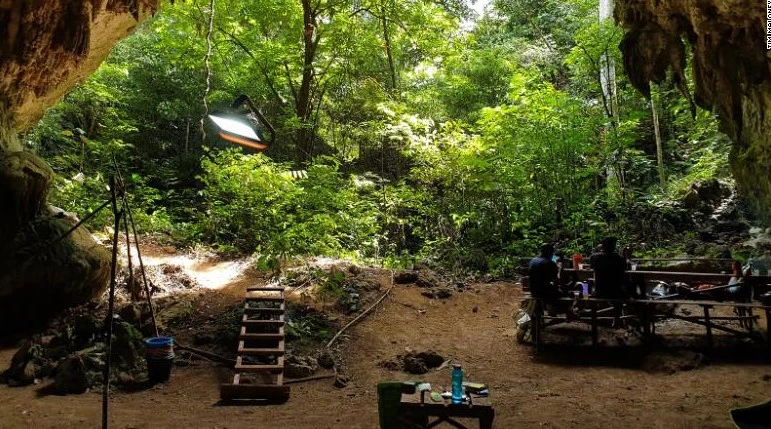 The bone was cut very cleanly, showing that ancient people in Indonesia had undergone amputation surgery. (Source: CNN)
The bone was cut very cleanly, showing that ancient people in Indonesia had undergone amputation surgery. (Source: CNN)Archaeologists have just found in a shallow grave, located in a rarely visited cave in Indonesia, the remains of a young person with traces that could change the history of medicine.
Using radiocarbon dating techniques, scientists estimate the remains located in Liang Tebo cave in eastern Kalimantan province have been undisturbed for 31,000 years, according to research published in the journal Nature on September 7.
But the most notable thing is that this remains, whether male or female, is missing its left leg. It appears that the leg was carefully amputated, when the person was in his teens or early teens, before dying of unknown causes between the ages of 19 and 21.

Australian and Indonesian archaeologists, who found relatively intact remains in 2020, assessed that the amputation showed considerable surgical skill of the ancients. If accurately verified, this could be the earliest case of amputation in history, completely changing our understanding of the level of Stone Age humans.
“This discovery is significant because it pushes back our established understanding of surgery,” said Maxime Aubert, a professor at Griffith University’s Center for Social and Cultural Research in Queensland, Australia. and complex medicine. Ancient people must have had extensive knowledge of anatomy, understood how to stop blood flow, how to give anesthesia and sterilize surgical equipment. All of this has only recently become the norm.”
 Liang Tebo Cave, where the archaeological team found unique remains. (Source: CNN)
Liang Tebo Cave, where the archaeological team found unique remains. (Source: CNN)Experts once thought that humans lacked the expertise to perform complex treatments such as amputations. They argue that this activity only occurred with the emergence of agriculture and permanent settlements that have transformed human society in the last 10,000 years.
Before the new discovery, the oldest known remains of a person undergoing surgery were an elderly farmer whose left forearm was amputated 7,000 years ago in what is now France. 100 years ago, amputation surgery became a regular practice in Western medicine. Research shows that before important research such as antibiotics became available, most patients would have died by the time they had to undergo amputation for treatment.
“Blood loss, shock and infection are the main causes of death after amputation,” said Tim Maloney, a researcher at Griffith University and one of the study’s co-authors. adding that throughout human history, this continued until recently.
According to the research team, the ancient patient in Indonesia had his left leg amputated when he was a child. This person lived another 6 to 9 years after surgery. There was no trace of infection in the bone, and new bone growth had formed over the amputated area – a phenomenon that takes time to occur. Additionally, while the rest of the skeleton is adult sized, the coccyx stops growing and retains the same size as when the patient was a child.

A surgeon or team of surgeons performed amputations 31,000 years ago. Maybe they used plasters and surgical tools made from stone. They also seem to have detailed knowledge of anatomy and the musculoskeletal system to perform surgery successfully, while preventing blood loss, infection, and death for patients.
After amputation, intensive care may become very important. The wound may have been regularly cleaned and disinfected. Additionally, to live in a mountainous area in ancient Indonesia, patients may have needed a lot of help from the community.
 Simulated image of an ancient patient after undergoing amputation surgery. (Source: CNN)
Simulated image of an ancient patient after undergoing amputation surgery. (Source: CNN)“This child survived surgery and lived for many more years,” said Charlotte Roberts, emeritus professor in the Department of Archeology at Durham University, UK, in a commentary published alongside the study. Later. This is very surprising.”
Roberts agrees with the team’s assessment that the limb was removed intentionally. Accidental amputation will not leave such a “clean” cut mark. There is also no evidence that the left leg was cut off as a punishment, which Roberts would have easily identified because she trained as a nurse before working as an archaeologist.
Australian scientists on the research team assessed that the surgical team probably had good knowledge of medicinal plants, such as antiseptics, that grow in the Borneo rainforest. It cannot be ruled out that they used these drugs to support surgical operations and post-operative treatment./.





